Pole und Asymptoten.pdf - gilligan-online
Pole und Asymptoten.pdf - gilligan-online
Pole und Asymptoten.pdf - gilligan-online
Erfolgreiche ePaper selbst erstellen
Machen Sie aus Ihren PDF Publikationen ein blätterbares Flipbook mit unserer einzigartigen Google optimierten e-Paper Software.
Aufgabe 3:<br />
2 2<br />
+<br />
x − 4t<br />
Für jedes t ∈ R ist durch ft<br />
(x) = mit x ∈D<br />
2 2<br />
f t<br />
eine Funktion f t gegeben. Ihr Schaubild<br />
x − t<br />
sei K. t<br />
Bestimme den umfassendsten Definitionsbereich D f t<br />
von der Funktion f t . Untersuche K t auf<br />
<strong>Asymptoten</strong>.<br />
Lösung:<br />
Bestimmung des maximalen Definitionsbereichs: Nennernullstellen müssen aus R entfernt<br />
werden.<br />
x<br />
2<br />
− t<br />
2<br />
= 0 ⇒<br />
x<br />
1,2<br />
= ± t<br />
⇒<br />
D<br />
f t<br />
= R /<br />
{ ± t}<br />
Diese Nennernullstellen sind nicht gleichzeitig auch Zählernullstellen <strong>und</strong> sie treten jeweils<br />
einfach auf, darum sind an diesen Stellen <strong>Pole</strong> mit Vorzeichenwechsel.<br />
<strong>Asymptoten</strong>:<br />
Der Zählergrad ist gleich dem Nennergrad: y = 1 ist waagrechte Asymptote.<br />
Aufgabe 4:<br />
x<br />
+<br />
a ⋅ e<br />
Für jedes a ∈ R ist durch fa (x) = ; x ∈ R eine Funktion f a gegeben. Ihr Schaubild sei<br />
K a . Bestimme die <strong>Asymptoten</strong>.<br />
a + e<br />
x<br />
Lösung:<br />
Für die Bestimmung der <strong>Asymptoten</strong> gilt:<br />
→<br />
0<br />
x x x<br />
a⋅e e a a⋅e<br />
lim f a(x) = lim = lim ⋅ = a lim f<br />
x x a a(x) = lim = 0<br />
x→+∞ x→+∞ x x x<br />
x<br />
a+ e →+∞ e x<br />
+ 1<br />
→−∞ →−∞ a+<br />
e<br />
e<br />
Aufgabe 5:<br />
+<br />
Für jedes t ∈ R ist eine Funktion f t gegeben durch f (x) =<br />
x<br />
e<br />
; x ∈ R /{ lnt}.<br />
Untersuche das Schaubild<br />
→0<br />
K t von f t auf <strong>Asymptoten</strong>.<br />
Lösung:<br />
Für die Bestimmung der <strong>Asymptoten</strong> gilt:<br />
lim<br />
t<br />
x→+∞<br />
f (x) =<br />
lim<br />
x→+∞<br />
x<br />
e<br />
=<br />
x<br />
e − t<br />
lim<br />
x→+∞<br />
e<br />
e<br />
x<br />
x<br />
1<br />
⋅<br />
1−<br />
t<br />
x<br />
e<br />
→0<br />
= 1<br />
t<br />
e<br />
x<br />
− t<br />
lim<br />
x→−∞<br />
f (x) =<br />
t<br />
lim<br />
x→−∞<br />
→0<br />
→<br />
0<br />
x<br />
e<br />
= 0<br />
x<br />
e<br />
− t<br />
→0<br />
© 2004 Jürgen Gilg · Alle Rechte vorbehalten · Nur zur privaten Nutzung · Öffentliche <strong>und</strong> kommerzielle Verwendung <strong>und</strong> Verbreitung sowie Vervielfältigung nur nach Rücksprache mit dem Autor<br />
2<br />
© j. gilg 04<br />
<strong>gilligan</strong>


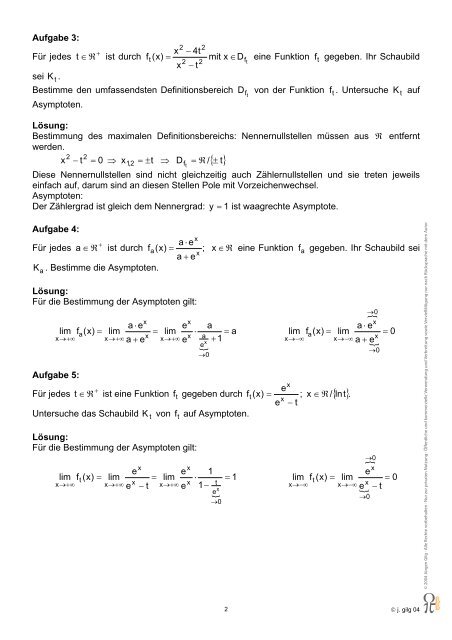
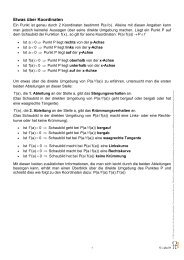
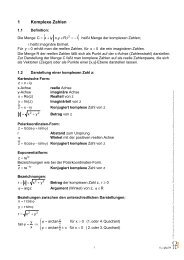
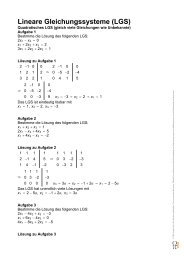
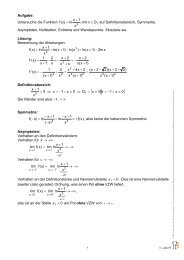

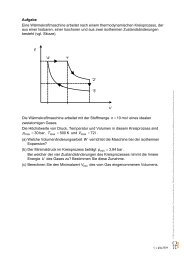
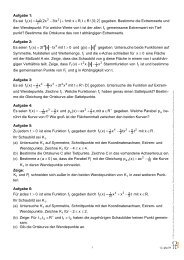


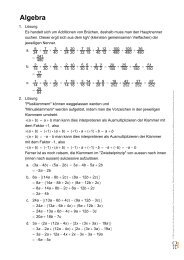

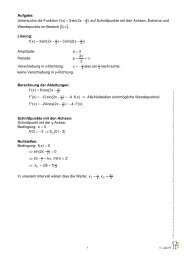

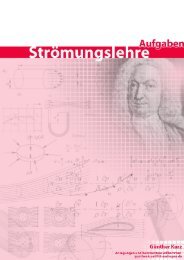
![[1.5pt] Wellenlehre[8.5pt] Zusammenfassung - gilligan-online](https://img.yumpu.com/21507627/1/184x260/15pt-wellenlehre85pt-zusammenfassung-gilligan-online.jpg?quality=85)